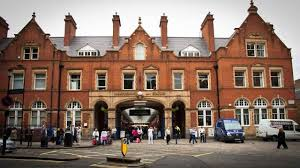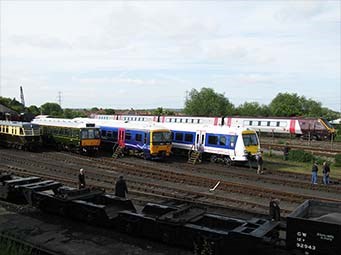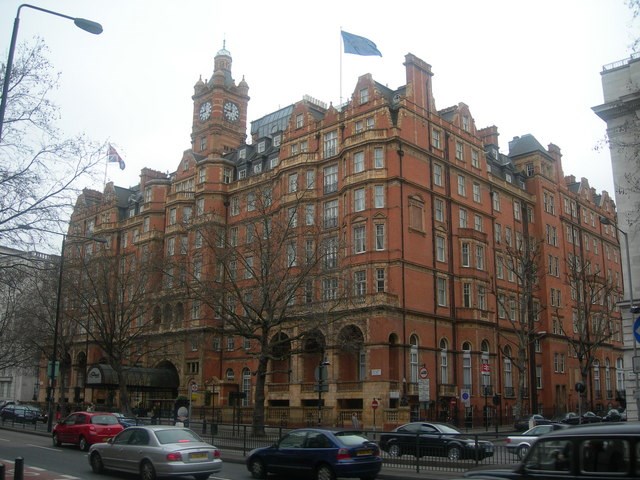SideTracked - London Marylebone Traditional Geocache
SideTracked - London Marylebone
-
Difficulty:
-

-
Terrain:
-

Size:  (micro)
(micro)
Related Web Page
Please note Use of geocaching.com services is subject to the terms and conditions
in our disclaimer.
SideTracked Caches are intended to provide quick Cache-and-dashes at Train Stations.
This is a magnetic micro hidden just round the corner of London Marylebone Station.
London Marylebone Station

London Marylebone Station was the last main line station to be built in London completed in 1899. During its construction over 500 houses had to be demolished to make way for the station and homes found for the 3000 people displaced by its construction.
Originally the terminus of the Great Central Railway (GCR) Main Line to Sheffield and Manchester. This line was closed in 1966 just north of Aylesbury, it now serves as the terminus for the Chiltern Railways.
As well as the youngest of all of the London stations it is also the smallest, having opened with only half of the originally planned platforms (two) in 1899, a further 2 built a few years later and then a further 2 in 2006. It is also the only London station that hosts Diesel trains, having no electrified lines.
Original plans for Marylebone show an eight-platform station, but with half of the platforms designated as a 'possible future extension'. The cost of building the GCR was far higher than expected, nearly bankrupting the company. Thus there was never enough money for the extra platforms, and only four platforms were built, three within the train shed and one west of the train shed (platform 4). As a result the concourse is unusually long and, for some 50 years, had only three walls, the northern wall being missing, since the GCR anticipated that the other four platforms, under an extended train shed, would be built later on. The cost of the London Extension also meant that the adjoining Great Central Hotel was built by a different company.
Passenger traffic on the GCR was never heavy, perhaps because it was the last main line to be built, which meant it had difficulty competing against longer-established rivals (especially the Midland Railway and its terminal St Pancras) for the lucrative intercity passenger business. Furthermore, for 40miles (64km) between Aylesbury and Rugby the line traversed thinly-populated countryside, thus attracting little passenger business at intermediate stations.
The GCR also struggled to compete with the Metropolitan Railway for 2nd- and 3rd-class traffic from nearby towns such as Harrow, Chesham and Aylesbury. However, the GCR had the upper hand on 1st-class travel between these towns, being quick, reliable and luxurious compared to the Met. Due to low passenger traffic, Marylebone was considered the quietest and most pleasant of London's termini. In 1903 there were only 14 daily passenger arrivals.
While passenger traffic was sparse, the line was heavily used for freight, especially coal, and goods trains ran from the north and East Midlands to the former Marylebone freight depot which used to adjoin the station. The heyday of the line was between 1923, when the GCR was absorbed into the LNER and 1948, when the LNER was nationalised to form the British Rail Eastern Region. As a result many prestigious locomotives, such as Flying Scotsman, Sir Nigel Gresley, and Mallard which ran on the East Coast Main Line, were also frequent visitors to the line. Special trains also ran on the line to destinations such as Scotland.

After the 1960s, lack of investment meant that the local services and the station itself became increasingly run down. Marylebone became the best place in London to see heritage trains. By the early 1980s Marylebone was under serious threat of closure. In 1983 British Rail chairman Peter Parker commissioned a report into the possibility of converting Marylebone into a 'high-speed bus way', whereby Marylebone would be converted into a coach station, The tracks between Marylebone and Harrow-on-the-Hill and South Ruislip would have been closed, and partly converted into a road for the exclusive use of buses and coaches.
As part of this proposal, British Rail services via High Wycombe would have been diverted into nearby Paddington, and the Aylesbury services would have been taken over by London Underground as part of an extended Metropolitan Line, and then routed to Baker Street. These proposals were seriously considered, and closure notices were posted at Marylebone in 1984. The closure proposals proved controversial, and faced strong opposition from local authorities. However they ultimately proved to be impractical and were quietly dropped.

The station today has gone through several moderations and is now a vibrant modern station. With Services running as far Birmingham and Aylesbury. Chiltern Railways fleet now include Class 82, 165 and 168. On the line that operates between Princess Risborough and Aylesbury a class 121 Bubble car.
The Great Central Hotel

The building opposite Marylebone station is a hotel that was originally one of London's Victorian era railway hotels, the Great Central Hotel. It was first proposed by Sir Edward Watkin of the Great Central Railway who envisaged Marylebone station, which the hotel was to serve, as the hub of an international railway which would run through a channel tunnel. Sir Edward's aspirations proved to be overambitious (not for the only time as he was behind the Watkins' Tower, which was a failed attempt to outdo the Eiffel Tower), and after the Great Central ran into financial difficulties the site of the hotel was sold to Sir John Blundell Maple of the furniture company Maples, who opened his hotel in 1899. Marylebone station is one of the smallest of the central London termini, but its hotel was among the grandest of the London railway hotels. It had a clock tower and was built around a large central courtyard. There were two main entrances, one on the northern side facing the station and the other on the southern side towards Marylebone Road. The architect was Colonel Sir Robert William Edis and the style was eclectic and opulent.
In the 1920s the central courtyard became a winter garden, but the building's first period as a hotel was drawing to a close. With railway traffic falling due to the advent of the motor car, London's railway hotels were among the most vulnerable of the city's grand hotels as they were not in the most fashionable districts. The Great Central fell out of hotel use for over forty years. It was a convalescent home during the Second World War and served as a military office building for many years afterwards as well as the headquarters of the British Railways Board, and was referred to by railway staff as "The Kremlin".
It is now a privately owned hotel.
Please note that the British Transport Police are aware of the Cache and do often check on it!
Additional Hints
(Decrypt)
Obfgba cynpr, fgerrg fvta